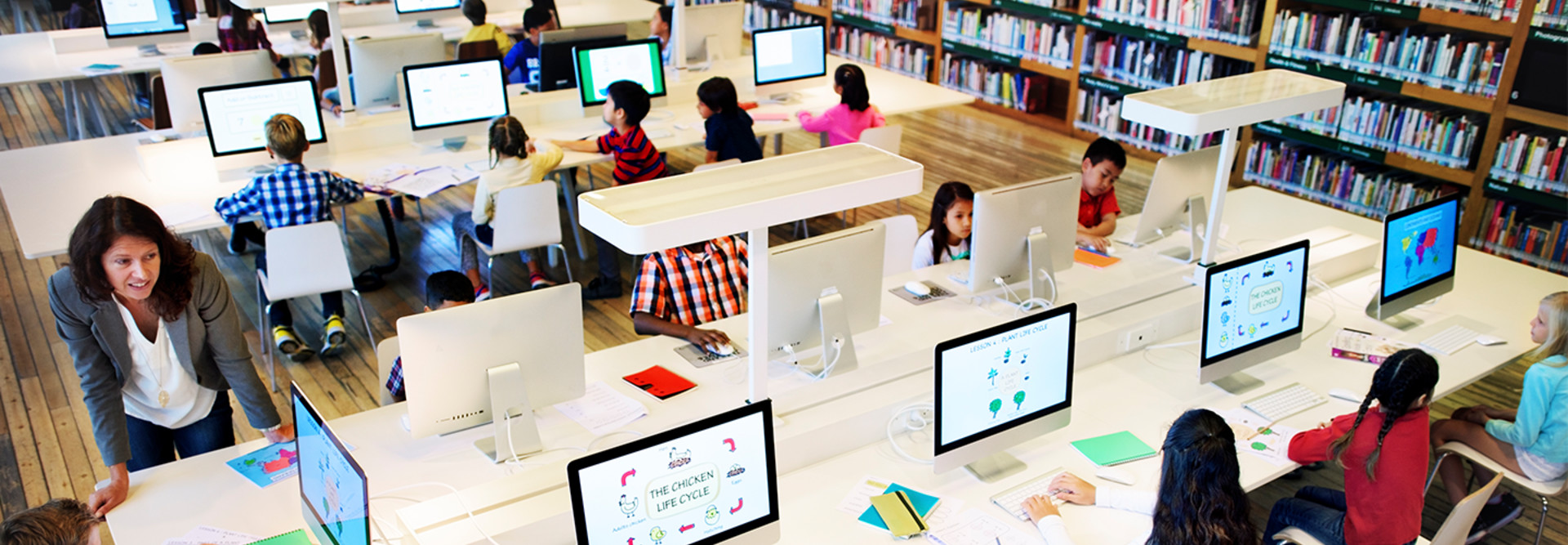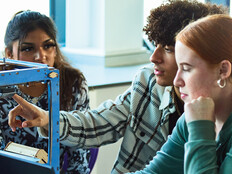K–12's Digital Transformation Is Giving Libraries a Modern Makeover
Today’s school libraries are being reinvented. No longer just a haven for dusty books and stern shushes, the library is now a place for digital resources and makerspaces and flexible learning. They’re alive with activity and are agents for collaboration and creativity.
Librarians are IT help desk masters, teachers of digital literacy and makerspace experts. The landscape of a K–12 library is changing with the times, and librarians oversee an important space for today’s modern learner.
MORE FROM EDTECH: Check out how libraries can use makerspaces to teach STEM!
Student Feedback Can Be Helpful for Library Design
Last year, at a cost of $50,000, Harbor Beach Community Schools in Michigan remodeled the library media center at the high school. The space was outfitted with modern furniture, laptops and audiovisual equipment.
The district asked students for design feedback, and the result is a comfortable space with soft armchairs and tall bistro tables.
“It’s a coffeehouse feel, warm and inviting,” Superintendent Shawn Bishop told EdTech for a previous story.
Library Makerspaces Are a Place to Create and Collaborate
Makerspaces encourage students to explore and create using science, technology, engineering and math concepts. Libraries are an ideal spot for these STEM spaces, where students tinker, code, problem-solve and build.
Administrators considering housing a makerspace in a library should make sure the library has a proper power supply for large equipment such as printers and audio/video infrastructure for games like “Minecraft.”
Besides expanding internet use, districts can outfit makerspaces with the proper tools and technology — laptops, 3D printing, coding kits — for students to get started.
Computer Labs Make Way for 1:1 Device Programs
With so many school districts going one-to-one with tablets or laptops, libraries are the new meeting space for tech-enabled teamwork. As such, modern libraries should be outfitted with robust broadband and plenty of places for students and educators to charge equipment. IT administrators must make sure there are enough manageable wireless access points and switches in the library to ensure proper capacity and coverage.
Because wireless networking can be an expensive endeavor, schools can use E-rate funding to pay for these upgrades. Libraries may apply annually through the federal Universal Service Administrative Company for eligible components to bolster high-speed internet.
MORE FROM EDTECH: Read more about the different levels of connectivity schools need from day-to-day!
Libraries Are Changing, and That Is Not a Bad Thing
For book lovers such as myself, libraries of the past (and present) hold an almost magical appeal — dust and all. Where else can you go to bury your nose in the middle of a 300-page tome, lose yourself to the adventure within and be surrounded by other bibliophiles?
The quiet solemnity of the library is being replaced by the vibrant hum of authentic learning and collaboration — and it’s a good thing. There will always be books. In fact, you can bury your nose in one just about anywhere, though maybe not surrounded by like-minded bookworms.
Libraries are headed into the future, and students and educators will reap the rewards.
This article is part of the "Connect IT: Bridging the Gap Between Education and Technology" series. Please join the discussion on Twitter by using the #ConnectIT hashtag.
![[title]Connect IT: Bridging the Gap Between Education and Technology [title]Connect IT: Bridging the Gap Between Education and Technology](http://www.edtechmagazine.com/k12/sites/default/files/articles/2014/05/connectit.jpg)









